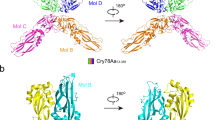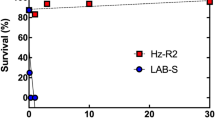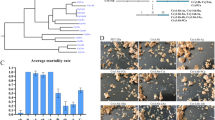Abstract
To obtain Bacillus thuringiensis crystal proteins with new properties and to identify the regions involved in insecticidal activity, we generated hybrid genes composed of cryIC and cryIE by in vivo recombination. Analysis of the hybrid proteins showed that domain III of CryIC is involved in the toxicity towards Spodoptera exigua and Mamestra brassicae. Transfer of this domain to CryIE, which is not active against these insects, resulted in a new protein with a broader activity. This hybrid protein binds to different receptors than CryIC, suggesting its use as an alternative for CryIC in resistance management programs.
This is a preview of subscription content, access via your institution
Access options
Subscribe to this journal
Receive 12 print issues and online access
$209.00 per year
only $17.42 per issue
Buy this article
- Purchase on Springer Link
- Instant access to full article PDF
Prices may be subject to local taxes which are calculated during checkout
Similar content being viewed by others
References
Höfte, H. and Whiteley, H.R. 1989. Insecticidal crystal proteins of Bacillus thuringiensis. Microbiol. Rev. 53: 242–255.
Li, J., Carroll, J. and Ellar, D.J. 1991. Crystal structure of insecticidal δ-endotoxin from Bacillus thuringiensis at 2. 5 Å resolution. Nature 353: 815–821.
Choma, C.T., Surewicz, W.K., Carey, P.R., Pozsgay, M., Raynor, T. and Kaplan, H. 1990. Unusual proteolysis of the protoxin and toxin from Bacillus thuringiensis. Structural implications. Eur. J. Biochem. 189: 523–527.
Hofmann, C., Vanderbruggen, H., Höfte, H., Van Rie, J., Jansens, S. and Van Mellaert, H. 1988. Specificity of Bacillus thuringiensis δ-endotoxins is correlated with the presence of high-affinity binding sites in the brush border membrane of target insect midguts. Proc. Natl. Acad. Sci. USA. 85: 7844–7848.
Van Rie, J., Jansens, S., Höfte, H., Degheele, D. and Van Mellaert, H. 1990. Receptors on the brush border membrane of the insect midgut as determinants of the specificity of Bacillus thuringiensis δ-endotoxins. Appl. Environ. Microbiol. 56: 1378–1385.
Van Rie, J., McGaughy, W.H., Johnson, D.E., Barnett, D. and Van Mellaert, H. 1990. Mechanism of insect resistance to the microbial insecticide Bacillus thuringiensis. Science 247: 72–74.
Ferré, J., Real, M.D., Van Rie, J., Jansens, S. and Peferoen, M. 1991. Resistance of the Bacillus thuringiensis bioinsecticide in field population of Plutella xylostella is due to a change in a midgut receptor. Proc. Natl. Acad. Sci. USA. 88: 5119–5123.
Visser, B., Van der Salm, T., Van den Brink, W. and Folkers, G. 1988. Genes from Bacillus thuringiensis entomocidus 60.5 coding for insect-specific crystal proteins. Mol. Gen. Genet. 212: 219–224.
Masson, L., Moar, W. J., Van Frankenhuyzen, K., Bossé, M. and Brousseau, R. 1992. Insecticidal properties of a crystal protein gene product isolated from Bacillus thuringiensis sbsp. kenyae. Appl. Environ. Microbiol. 58: 642–646.
Visser, B., Munsterman, E., Stoker, A. and Dirkse, W.G. 1990. A novel Bacillus thuringiensis gene encoding a Spodoptera exigua-specific crystal protein. J. Bacteriol. 172: 6783–6788.
Sambrook, J., Fritz, E.F. and Maniatis, T. 1989. Molecular Cloning: A Laboratory Manual. Cold Spring Harbor Laboratory, Cold Spring Harbor, N.Y.
Convents, D., Houssier, C., Lasters, I. and Lauwereys, M. 1990. The Bacillus thuringiensis δ-endotoxin. Evidence for a two domain structure of the minimal toxic fragment. J. Biol. Chem. 265: 1369–1375.
Convents, D., Cherlet, M., Van Damme, J., Lasters, I. and Lauwereys, M. 1991. Two structural domains as a general fold of the toxic fragment of the Bacillus thuringiensis δ-endotoxins. Eur. J. Biochem. 195: 631–635.
Ge, A.Z., Shivarova, N.I. and Dean, D. 1989. Location of the Bomhyx mori specificity domain on a Bacillus thuringiensis δ-endotoxin protein. Proc. Natl. Acad. Sci. USA 86: 4037–4041.
Ge, A.Z., Rivers, D., Milne, R.E. and Dean, D. 1991. Functional domains of Bacillus thuringiensis insecticidal proteins. J. Biol. Chem. 266: 17954–17958.
Lee, M.K., Milne, R.E., Ge, A.Z. and Dean, D.H. 1992. Location of a Bombyx-mori receptor binding region on a Bacillus-thuringiensis δ-endotoxin. J. Biol. Chem. 267: 3115–3121.
Author information
Authors and Affiliations
Corresponding author
Rights and permissions
About this article
Cite this article
Bosch, D., Schipper, B., Kleij, H. et al. Recombinant Bacillus thuringiensis Crystal Proteins with New Properties: Possibilities for Resistance Management. Nat Biotechnol 12, 915–918 (1994). https://doi.org/10.1038/nbt0994-915
Received:
Accepted:
Issue Date:
DOI: https://doi.org/10.1038/nbt0994-915
This article is cited by
-
Development of leaffolder resistant transgenic rice expressing cry2AX1 gene driven by green tissue-specific rbcS promoter
World Journal of Microbiology and Biotechnology (2016)
-
Transgenics in groundnut (Arachis hypogaea L.) expressing cry1AcF gene for resistance to Spodoptera litura (F.)
Physiology and Molecular Biology of Plants (2013)
-
RETRACTED ARTICLE: Preliminary comparing the toxicities of the hybrid cry1Acs fused with different heterogenous genes provided guidance for the fusion expression of Cry proteins
World Journal of Microbiology and Biotechnology (2012)
-
Is the German suspension of MON810 maize cultivation scientifically justified?
Transgenic Research (2010)
-
Molecular approaches for identification and construction of novel insecticidal genes for crop protection
World Journal of Microbiology and Biotechnology (2006)



